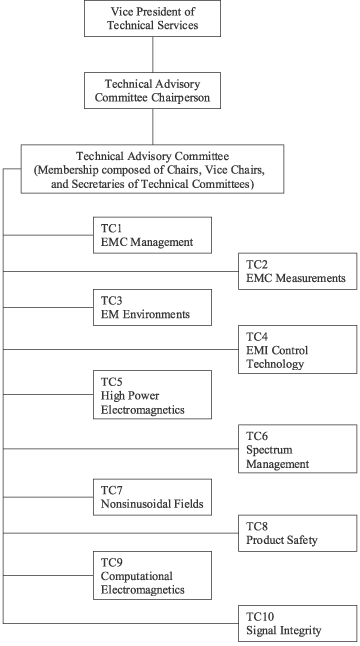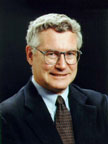 |
| Fig.1 – Organizational Relationship
Between Board of Directors and TAC |
“Managing engineers is like herding cats.”
How many of us have heard this axiom, and have echoed it as we
bemoan yet another bout with attempting to accomplish the merely
mundane with a staff of experienced, highly educated individualists
otherwise known as “the engineering staff”? Many of
us who now find themselves managers at one level or another are
also engineers by discipline. Injecting common sense into the
process, a methodology we used to advantage in our salad days
as designers and/or troubleshooters, is in general the way most
of us try to attack the problems of everyday management of the
folks without whom we couldn’t get the job done. The reality
is that management of highly trained professionals presents many
more challenges than just trying to get the latest max-gain amplifier
design to amplify and not oscillate, or solving the simplistic
problems of achieving synergy between the conducted interference
characteristics requirements and the operational stability of
the company’s most recent DC/DC converter application. Engineers,
by their nature, are very likely to question authority, and in
general, desire to work independently. These can be admirable
traits, particularly in those who are counted on to bring innovation
and creativity into the process. Unfortunately, these traits also
make it difficult to maintain any semblance of herd control for
the typical engineering manager.
Now, carry the above concept a step further. What about the aspiring
IEEE EMC Society (EMCS) Technical Committee (TC) officer, faced
with the prospect of managing a group of volunteer electromagnetic
compatibility engineers? These volunteers are professionals all,
with prior commitment to job and family outside of their EMCS
TC obligations, who once a year or so show up at a more or less
loosely organized meeting to discuss the progress, or lack thereof,
of their respective duties assigned the previous year. These are
engineers who have chosen a discipline that treads the border
between physics and electrical engineering, that often spans project
development from the circuit board to final platform integration.
EMC engineers are interested in solving problems like protecting
aircraft from the caress of a 200 thousand ampere lightning attachment.
How can anyone expect these folks to be too concerned with following
Robert’s Rules of Order once a year? Clearly, organization
on the part of the TC officer is a must if TC activities are to
be meaningful and successful. In turn, TC success is at the foundation
of the ability of the Society to bring cutting edge knowledge
and expertise in electromagnetic compatibility to the forefront
of the discipline. Of equal importance to the success of TC activity
is training the TC members to assume the role of TC officer. Officer
succession is key to the health and ongoing revitalization of
the TCs, and ultimately of the EMCS as a whole. It is incumbent
on older, more experienced members of the Society, as they move
up in the ranks, to facilitate the process of training and preparing
the younger members of the Society to move in and assume the role
of leadership at the lower levels.
Which brings me to the topic of this newsletter article, EMC Management
Tools. By careful web surfing, one can find on the TC1 web page
(web address is https://www.ewh.ieee.org/soc/emcs/tc1/tc1rpts.htm)
a zip file under the name of “EMC Management Tools (.zip
format)”. Downloading this 264kB file and unzipping it yields
a bounty of practical software tools that can be readily adapted
to the organizational needs of any EMCS TC officer.
For example, a meeting is far more easily managed for content
and time with an agenda to follow. MtgAgenda.doc, a Microsoft
Word file, admirably fills the need for a simple template that
can be adapted to any TC for any meeting. Companion templates
to MtgAgenda.doc, whose titles are self-explanatory, are MtgNotice.doc,
MtgSignInSht.doc, and MtgMinutes.doc. In addition to these, a
Microsoft Excel Spreadsheet file, ActionList.xls, is available
to track assigned action items from meeting activities. Finally,
at least once a year, each TC is expected to submit a status report
to the Technical Advisory Committee (TAC). StatusReport.doc can
be a very useful tool in collecting, organizing, and reporting
the previous years’ TC activities to the TAC Chair. Any TC
officer who wishes can employ any or all of these templates to
aid in the simplification of meeting planning, control, and reporting.
As indicated above, officer progression is key to the health and
ongoing revitalization of the TCs, and ultimately of the EMCS
as a whole. In order to facilitate this process, a number of tools
are available to the TC officer who wishes to engage his committee
members in proper training and preparation for advancement. For
example, there are two versions of a record sheet, one named OfficerTraining.doc,
the other named Officer_trng.xls. These two files are essentially
identical lists of topic headings to spur the thought process
as to what information should be passed on to the trainee member(s).
The TC officer has a choice of format, and of course may add more
topics to the list as they come to mind. And, to keep track of
the progress of the trainees, the TC officer has Training_Log.xls
ready at hand to log the topic, reference material, trainee name,
and date of training completion.
Three documents are available to the TC officer to provide thought
jogging guidance in the areas of how to run a TC (HowToLeadCom.doc),
what TC leadership is all about (LEADERSHIP.doc), and finally,
a one page document that talks to the philosophy/methodology of
TC Officer progression within the EMCS.
As with any collection of such tools, there are a couple of miscellaneous
documents to be found amongst the rest. Presentation_Fmt.ppt is
actually a copy of a presentation made by Dave Southworth that
talks about TC Electronic Communication, and incidentally provides
some very good information about setting up and running successfully
a majordomo for a TC. This same process has been used already
to set up majordomos for TC1, TC4, and the TAC. Two different
but very similar files provide a letterhead template; one is identified
as TC-1_Letterhead.doc, the other simply Letterhead.doc. The use
of these templates is quite obvious upon opening the file(s).
DocumentList.doc is another thought jogger, intended to aid in
planning of a number of separate, but related tasks such as leadership,
meeting planning, even testing/analysis activities. Finally, there
is TestCertification_Record.xls, a spreadsheet file designed to
aid in the preparation of a test facility for audit inspection,
such as one might encounter for a formal laboratory accreditation.
Well, I hope this brief discussion and description of the Management
Tools available to all on the TC1 website has been brief and interesting
enough to pique the interest, and perhaps even motivate one or
two folks to go check out the files. Good Luck in your Leadership
roles, whatever they may be!
Technical Committee 1 – EMC Management
This committee is concerned with the development and dissemination
of Best Practices and Methodologies for the successful leadership,
supervision and guidance of EMC related activities. These Best
Practices and Methodologies shall be structured so as to provide
assistance to all managers, and engineers. Appropriate and convenient
tools shall serve as a foundation to these Best Practices and
Methodologies.
Chair: Dan Hoolihan
Vice Chair: Dave Southworth
Secretary: Bob Scully
Technical Committee 2 – EMC Measurements
This committee is concerned with the measurement and instrumentation
requirements in EMC standards and procedures and how they are
interpreted. Also concerned with the adequacy of measurement procedures
and measurement instrumentation specifications for radiated and
conducted emission and susceptibility tests and the rationale
for performance limits for these tests.
Chair: Don Heirman
Vice Chair: Bob Hofmann
Secretary: Ed Bronaugh
Technical Committee 3 – Electromagnetic
Environment
The charter of TC3, the Technical Committee on Electromagnetic
Environment, is to encourage research on the:
a) electromagnetic environment (EME),
b) development of standards for EME measurement and characterization,
c) natural and man-made sources of electromagnetic environment
that comprise this environment,
d) effects of noise (unwanted portions of EME) on systems performance,
and
e) effects of international civil and military standards intended
to control man-made intentional and unintentional emissions of
electromagnetic energy.
Chair: Don Gilliland
Vice Chair: Bill Strauss
Secretary: Ray Siu
Technical Committee 4 – EMI Control
Technology
This committee is concerned with the fundamentals of transmission/propagation
media and interference control technology, together with associated
design, analysis, and techniques useful for the identification,
characterization, control and mitigation of electromagnetic interference
at the system, subsystem and unit levels.
Chair: Bob Scully
Vice Chair: Dan Modi
Secretary: Kermit Phipps
Technical Committee 5 – High Power Electromagnetics
This committee is concerned with the effects and protection methods
for electronic equipment and systems for all types of high power
electromagnetic environments. These environments include electromagnetic
pulse (EMP), intentional EMI environments (e.g. high power microwaves
and ultrawideband), lightning electromagnetic currents and fields,
and electrostatic discharge. Interactions with aircraft and other
mobile systems are included.
Chair: William Radasky
Vice Chair: Michael McInerney
Secretary: vacant
Technical Committee 6 – Spectrum Management
This committee is concerned with frequency coordination, management
procedures for efficient spectrum use, band occupancy and congestion,
federal regulations and their adequacy.
Chair: Tom Fagan
Vice Chair: Michele Brown
Secretary: vacant
Technical Committee 7 – Nonsinusoidal
Fields
This committee is concerned with the application of electromagnetic
signals with large relative bandwidth, commonly referred to as
non-sinusoidal waves, delineation of the differences between time-domain
and frequency-domain principles, analytical and numerical treatments
of the Maxwell postulates directly in time-domain, conceptualization,
design, fabrication and testing of materials and devices for ultra-wide
bandwidth systems.
Chair: William Croisant
Vice Chair: Michael McInerney
Secretary: vacant
Technical Committee 8 – Electromagnetic
Product Safety
TC8 has formed the Product Safety Technical Committee, whose charter
is to develop itself into an autonomous IEEE Product Safety Society,
with support from the IEEE EMC Society. The IEEE Product Safety
Engineering Society will address safety engineering for equipment
and devices used in the scientific, engineering, industrial, commercial
and residential arenas. It will allow engineers and other technical
professionals an opportunity to discuss and disseminate technical
information, to enhance professional skills, and to provide outreach
to engineers, students and others with an interest in the field.
The new Society will accept members for the 2004 membership year.
Chair: Richard Georgerian
Vice Chair: Dan Modi
Secretary: Jim Bacher
Technical Committee 9 – Computational
Electromagnetics
This committee is concerned with broad aspects of Applied Computational
Electromagnetic techniques that can be used to model electromagnetic
interaction phenomena in circuits, devices, and systems. The primary
focus is with the identification of the modeling methods that
can be applied to interference (EMC) phenomena, their validation
and delineating the practical limits of their applicability. Included
are low and high frequency spectral-domain techniques and time-domain
methods.
Chair: Christopher Holloway
Vice Chair: Zorica Pantic-Tanner
Secretary: Jun Fan
Technical Committee 10 – Signal Integrity
This committee is concerned with the design, analysis, simulation,
modeling and measurement techniques useful in maintaining the
quality of electrical signals. These activities encompass all
aspects of signal integrity from the integrated circuit level
to the system level.
Chair: Jim Drewniak
Vice Chair: John Howard
Secretary: Ross Carlton
EMC
 EMC
Management Tools
EMC
Management Tools